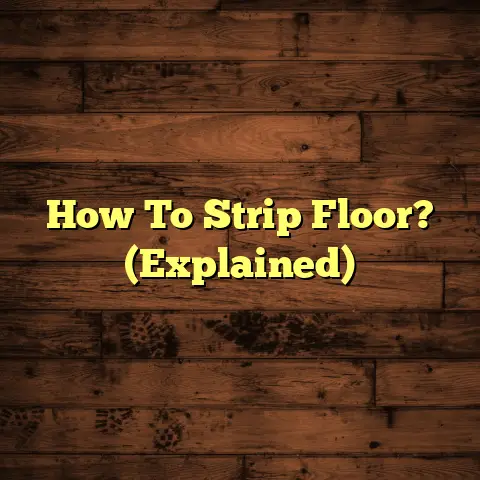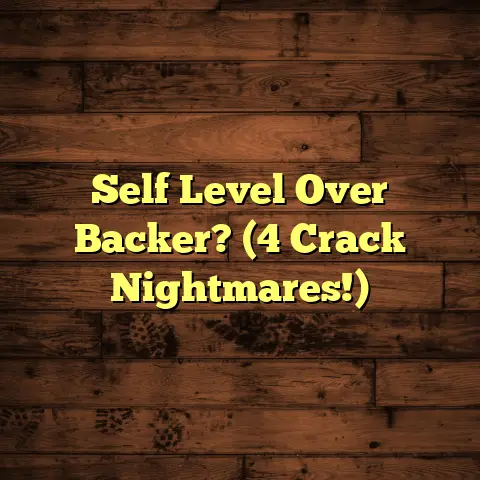How To Protect Hardwood Floors When Moving Furniture? (Explained)
When it comes to protecting hardwood floors while moving furniture, I’ve learned that a little preparation goes a long way. Hardwood floors can be stunning, but they are also susceptible to scratches, dents, and other damage if not handled carefully. In this article, I’ll share my experiences, challenges, and tips for keeping your floors safe during a move.
Preparing for the Move
Before I started moving furniture, I took the time to prepare my space. Here’s what I did:
Clear the Area
I removed all small items from the room to have a clear path. This made the process smoother and reduced the risk of tripping. I also assessed the layout to determine the most efficient route for moving larger pieces.
Measure Furniture
Measuring my furniture dimensions ensured it would fit through doorways and hallways without excessive force. This step saved me from potential mishaps, like getting stuck in a tight spot or damaging the walls.
Gather Supplies
Here’s a list of supplies that I found essential:
- Furniture Sliders: These come in various sizes and materials, generally costing around $10 for a pack of four. Felt sliders are ideal for hardwood floors.
- Moving Blankets: Priced at about $15 each, these protect both the furniture and the flooring from scratches.
- Cardboard: Free from local stores, cardboard can be cut into sections to create protective barriers on the floor.
- Tape: Around $5 for a roll, tape can secure blankets or cardboard in place.
- Soft Cloths or Towels: Using these can add extra cushioning for delicate items.
Techniques for Protecting Hardwood Floors
Now that I had my supplies ready, I focused on specific techniques to protect my hardwood floors during the move.
Using Furniture Sliders
One of the best investments I made was in furniture sliders. They come in various sizes and types for different floor surfaces. I used felt sliders for my hardwood floors, which worked wonders. When moving my heavy couch, I placed sliders under each leg. The couch glided effortlessly across the floor without any scratches.
Advantages:
- Protects floors from scratches.
- Makes it easier to move heavy items.
Disadvantages:
- Sliders can sometimes slip out from under furniture if not placed carefully.
- They may not work well on all types of furniture legs.
Moving Blankets and Cardboard
During my moves, I also utilized moving blankets and cardboard. I draped moving blankets over my furniture to protect them from impact during the move. For delicate pieces like my dining table, I cut cardboard into sections and placed them on the floor where I planned to move it.
These methods helped prevent damage not just to the floors but also to the furniture itself.
The Challenge of Heavy Items
While I had success with lighter furniture using sliders, I faced challenges with heavier items like my solid wood dresser. It was cumbersome, and I realized that lifting it directly could cause serious damage to both the dresser and my hardwood floor.
To overcome this, I gathered a few friends to help lift it slowly while another person used sliders underneath. Teamwork made the process much smoother, and we avoided any mishaps.
Additional Moving Techniques
Lifting vs. Dragging
One crucial lesson I learned was the importance of lifting rather than dragging heavy items across the floor. Dragging can easily scratch hardwood surfaces, leading to costly repairs or refinishing later on. Whenever possible, I encouraged lifting items and using sliders or dollies instead.
Using a Dolly
For particularly heavy pieces such as my refrigerator or large entertainment center, I rented a dolly from a local hardware store for approximately $20 per day. A dolly allows for safe transportation without risking damage to both the flooring and the furniture itself.
- Securing Items on the Dolly: If you’re using a dolly, it’s essential to secure your items with straps or rope to prevent them from shifting during transport.
- Navigating Corners: When navigating corners with a dolly, tilt the dolly slightly to allow for smooth transitions without hitting walls or door frames.
Protective Gear for Floors
In addition to using sliders and blankets, I found that using protective gear specifically designed for hardwood floors helped reduce damage further.
Floor Protectors
I installed floor protectors on the legs of my furniture after moving them in place. These protectors come in various materials, including felt and rubber:
- Felt Pads: Great for everyday use, these pads help reduce scratches when moving furniture slightly.
- Rubber Caps: Ideal for heavier furniture that may need to be moved often; they offer more durability than felt pads.
The cost of floor protector pads varies but generally ranges from $10 to $30 depending on size and quality.
Moving Specific Types of Furniture
Certain types of furniture require special attention when moving to avoid damaging hardwood floors. Here are some examples based on my experiences:
Sofas and Couches
Sofas tend to be bulky and heavy. As mentioned earlier, using sliders is key here. Additionally, removing cushions before moving can lighten the load significantly.
- Remove Legs: If possible, remove the legs before moving a sofa; this reduces height and makes maneuvering through doorways easier.
- Angle It Right: When turning corners with a sofa, angle it slightly to minimize contact with walls and prevent scraping the floor.
Dressers and Cabinets
Heavy dressers can pose challenges due to their weight.
- Empty Contents First: Always empty drawers before attempting to move them. This makes them lighter and easier to handle.
- Use Blankets: Wrap dressers in moving blankets to protect both surfaces during transport.
Beds
Beds can be tricky because they often have sharp corners and heavy frames.
- Disassemble When Possible: If your bed frame allows it, disassemble as much as possible before moving.
- Use Soft Padding: Placing towels or blankets over any sharp edges protects both your bed frame and your hardwood floor.
Dealing with Stairs
If you have stairs involved in your move, additional precautions are necessary:
- Use Ramps: If you have access to ramps (which can sometimes be rented), they make moving heavy items up or down stairs much safer.
- Team Coordination: When moving items up or down stairs, clear communication with your team is vital. One person should guide while others lift to ensure safety.
Challenges Encountered During Moves
Throughout my experiences with moving furniture, I encountered several challenges worth discussing:
- Unexpected Heavy Items: On one occasion, I misjudged the weight of an antique armoire. It took three people to lift it safely down the stairs while ensuring we didn’t damage the walls or floors.
- Scratched Floors: The first time I moved heavy furniture without adequate protection led to noticeable scratches on my hardwood flooring. It was a hard lesson learned; now I’m meticulous about protecting surfaces.
- Tight Spaces: Maneuvering large pieces through narrow hallways has proven challenging. On one occasion, we had to remove a door from its hinges just to get a dresser through!
Cleaning Up After Moving
Once everything is moved in place, cleaning up becomes essential:
- Sweep/Vacuum Thoroughly: To remove any dust or debris left behind that could scratch floors over time.
- Spot Clean Any Marks: If any marks were left on the floor during the move, using a gentle hardwood cleaner often does the trick without damaging the finish.
- Inspect for Damage: After everything is set up, inspect your floors closely for any potential damage caused during the move so you can address it promptly.
Maintenance for Longevity
After successfully moving your furniture, maintenance is crucial for keeping your hardwood floors looking great. Here are some steps I take:
- Regular Cleaning: Sweeping or vacuuming frequently helps remove dust and debris that could scratch the surface.
- Use Floor Mats: Placing mats in high-traffic areas reduces wear and tear significantly.
- Refinishing: Depending on how often I move furniture (and how careful we are), refinishing might be necessary every few years to restore the floor’s original luster.
Conclusion
In conclusion, protecting hardwood floors when moving furniture involves careful planning and the right tools. My experiences with sliders, blankets, dollies, and teamwork have proven effective in safeguarding my investment while ensuring an efficient moving process. By sharing these insights, tips, and techniques with you, I hope to make your next move easier while keeping your hardwood floors in pristine condition!
Comparative Analysis of Similar Products/Techniques
When considering options for protecting hardwood floors during moves, here’s a comparative analysis based on my experiences:
| Product/Technique | Advantages | Disadvantages |
|---|---|---|
| Furniture Sliders | Easy to use; reduces friction | Can slip out if not placed correctly |
| Moving Blankets | Versatile protection; reusable | Can be cumbersome; requires storage |
| Dollies | Great for heavy items; reduces strain | Requires renting/purchasing; maneuvering can be tricky |
| Floor Protectors | Long-term protection; easy installation | May need replacement periodically |
By weighing these options against each other based on personal experience and practical application, you can make informed decisions tailored to your specific needs when protecting your hardwood floors during moves.
Final Thoughts
Moving furniture doesn’t have to be stressful or damaging to your beautiful hardwood floors if you take time to prepare adequately and utilize protective measures effectively. With careful planning and consideration of each piece of furniture’s unique requirements, you’ll not only keep your floors safe but also enjoy a smoother moving experience overall!





